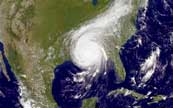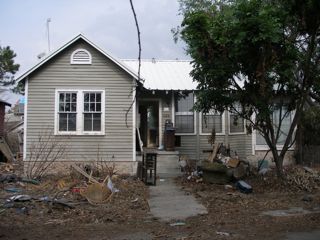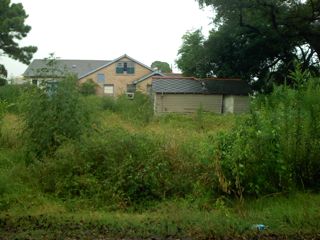 Katrina
Update #86
Katrina
Update #86 Katrina
Update #86
Katrina
Update #86Every now and then I still get emails from those of you who peek in to see if I have done an update. As busy as I have been, I could not allow the two year anniversary of Katrina to pass without at least saying something. My lack of writing has had more to do with not having the time to do it, rather than not having something to say. Since Christmas 2006 (my last update), Janis and I have literally been from one corner of the country to the other — from Key West to Seattle. In our travels, the question is always the same when someone hears we are from New Orleans: "how are things going down there?," followed closely by "how did you make out?," or words to that effect. I haven't even had time to work on that web site makeover I kept referring to last year.
Two years later, New Orleans is still very much a tale of two cities, with the "sliver by the river" thriving beyond its pre-Katrina levels, while the other two-thirds of the city struggle. It has been estimated that the area between I-10 and the Mississippi River (the afore-mentioned "sliver by the river" is at about 125% of it's pre-Katrina population. The economy is also split very much in two, as the convention and tourism industries have pretty much recovered. New Orleans well-known restaurant scene has even excelled over it's pre-Katrina levels: in July 2005 there were 809 restaurants open in the city of New Orleans. Today, there are 853! (Source: Tom Fitzmorris' The New Orleans Menu website.)
Two years later, the area between I-10 and Lake Ponchartrain has been much slower to recover, however. These are the low-lying areas that were most damaged by the massive flooding caused when four levee's in New Orleans breeched. Here and there, a home has been repaired and re-occupied. Here and there, homes have been demolished and the land cleared. Here and there, new homes have been built or old ones raised as high as 8, 10, or 12 feet. But for the most part you still see miles, and miles, and miles of unoccupied, mostly gutted, homes. While New Orleans' population is estimated to be as much as 60 percent of its pre-Katrina population, most are living closer to the river — abandoning the land so prone to flooding.
But as slow as things seem to be changing, they are, as the pictures below demonstrate:


On the left is a picture of Coop's house taken on 11/4/2005 — just 5 weeks after the storm. On the right is what that same parcel of land looks like on August 28, 2007. The sidewalk leading up to the house was just a smidgen to the right of center in the picture on the right. There are hundreds of lots like this and thousands of homes still waiting to be demolished. Coop has moved into a new house in Metairie, which he spent about a year remodeling.
Two years later and St. Charles Avenue is still devoid of the sounds of streetcars traveling back and forth, although work continues on the rebuilding of the line. In the mean time, they have put the green St. Charles streetcars in service on the Canal Street line, as all but one of the red Canal streetcars were destroyed by Katrina's flooding.
Another significant shift has happened to New Orleans' nightlife. While there are still plenty of places one can go at any hour of the night or day to get a drink, the non-smoking law that went into effect on January 1, 2007 has changed the places people hang out. The law is that if a business derrives more than 50% of its income from serving food, then smoking is not permitted inside. Since the smoke bone seems to be connected to the drink bone for so many people, this has made places like Coop's Place less attractive for late night activities. Where Coop's Place used to close the kitchen at 1 or 2 AM and close at 3, now it they close the kitchen as early as midnight and are out of the bar by 1 or 2 AM.
It is too early to tell, but it almost feels like New Orleans is going through a slow metamorphosis to a place that is almost exclusively a tourist destination. Janis and I spent this past Easter weekend in Key West – a place a lot like New Orleans in so many ways. Like New Orleans, it has a "tourist district," and like New Orleans, it also has a residential section. In its past, Key West also had various other industries, all of which moved to other locations not as subject to Mother Nature's wrath. New Orleans' oil industry bolted to Texas a long time ago. At this point there are really only three types of industry in New Orleans: ship building, government-related, and Tourism. There is a budding movie industry, but it is too early to tell if it will have a long lasting impact on the local economy.
Here's the thing: at this point, the vast majority of people who are coming back are here. We aren't going to see a mass re-settlement of the areas that were flooded by Katrina. Those people have settled in to their new lives, and as I have discussed in these pages before, really can't afford to move back because the government that paid to move them out will not pay to move them back. Any settlement in those areas will come from new people. But does New Orleans have what it takes to grab the opportunity. Based on what I have seen in the past two years, if New Orleans evolves into a tourism-based economy, it will be by luck more than design. But here is what that New Orleans could look like:
Obviously, the French Quarter will be at the heart of any effort to build a tourism-based economy. But the reality is that about half the Quarter is residential, and those people love their life there. After all, who wouldn't want to be neighbors with the likes of Brad and Angelina? If New Orleans is to succeed as a tourism mecca, it will need to bring more variety into the area. The Mississippi Gulf Coast is back in business, thanks to Mississippi's bold move to approve land-based casinos (as opposed to only allowing barge-based floating casinos before Katrina). The Hard Rock hotel, which was about to open when Katrina hit had employeed 1,250 people before the storm. Today, with a brand new land-based casino that is much larger, they employ over twice that many.
For many years, locals have complained about the "Disneyfication" of New Orleans. As much as I hate to see it happen on one hand, that might be the shot in the arm that New Orleans needs. Maybe New Orleans needs to be the Las Vegas of the south. If New Orleans can figure out how to evolve into a more agressive tourism-based economy without losing its "European charm" it might just have something. Of course, in order to do that it will need to have better leadership. Right now, we have a mayor whose idea of promoting the city is to tell people that New Orleans' high murder rate is a "two-edged sword" adding that it "keeps the New Orleans brand out there."
WHAT? "Step right up folks – come see the murder captial of the US. But don't worry, it's all gang and drug related. You are safe as if you were in Fort Knox here - as long as you stay in the French Quarter and we don't have a hurricane."
See what I mean? Not the kind of publicity we need or want. In this case, bad publicity may not be better than no publicity. But who knows? Maybe he is onto something. If it weren't for Katrina, the tour companies — who used to take people to cemeteries, plantations, and swamps — now make most of their money from Katrina tours."Our survival depends on it," said Isabelle Cossart of Tours by Isabelle. "If I quit doing the post-Katrina city tour, I'm out of business."
To be fair, the killings really are drug and gang related — no tourists are getting harmed, and they won't as long as they stay where tourists are supposed to stay. It was also the same C. Ray Nagin who suggested creating a "casino zone" in the heart of the CBD, thus offering more variety than the French Quarter offers by itself, and allowing New Orleans to tap into some of the gambling economy that has so successfully contributed to the ongoing rebuilding of the Mississippi Gulf Coast. I kind of liked that idea, and was surprised it came from Nagin. And it was perhaps because it came from Nagin that it was shot down so quickly.
Like Key West, however, New Orleans will also need to adjust to a seasonal economy. As much as they might try to get people here during the summer, I can't imagine many people deciding to visit a hot and sweatty swamp prone to flooding, and with limited ways out of the city should a hurricane approach. But for the rest of the year, New Orleans truly is a thing of beauty, storm or no storm.
Part time New Orleans resident Harry Shearer, on his excellent Le Show, refers to Santa Monica, CA as the "Home of the Homeless." Two years later, and New Orleans has 12,000 people living on the streets, twice as many as before the storm, which could make New Orleans the new "Home of the Homeless." Some of them have set up camp in a public area across from City Hall to make a point to the city government. To be honest, I don't get it. The claim is that despite many of these people having jobs, they can't afford a place to live. Hmmm... I have three adult kids, all of whom are working in the service industry who have a). no trouble finding a place to live, and b). no trouble paying their rent. Supposedly, many of these people are working either in the service industry or in construction (which typically pays better than the service industry). So I don't understand why someone is homeless.
All is not rosey, of course, in the job market. Just after the storm workers were so scarce that fast food restaurants were offering $10-$12 per hour and as much as $500 per month bonuses. As more workers arrived in the city, those higher-priced workers were fired, to be replaced with those making closer to minimum wage. The construction market has also leveled off. For the most part, anyone who is going to get something built or repaired has either done so, although there are still almost 150,000 people waiting for their money from the "Road Home" program (see below). Even as these people get their money, it will probably only keep things running at about the current rate. It certainly won't result in another construction boom.
Yes, it is true that rents have gone up by as much as 30%, but that has leveled off considerablyin the past few months. Rents are still higher than they were before the storm, but not as higher as they were in late 2005 and early 2006. I don't mean to belittle any of these people. Maybe they just don't know how to go about finding a place? Maybe they are spending their money on drugs or booze and don't have any money left over for rent? I don't have the answer, but I don't think the issue is that they can't afford to pay rent.
Two years later, the storm continues to claim victims. This time, it's poisoning from prolonged exposure to Formaldehyde, which is released by plywood and spray-on insulating foam — both of which are used in abundance in the trailers FEMA used to house displaced residents. These trailers were never meant for long-term use. They are meant for use as weekend getaways, or, at best, a week or two at a time for a vacation. The prolonged exposure has resulted in headaches, burning in the eyes and throat, nausea, and difficulty breathing. Formaldehyde may also cause cancer.
Louisiana's "Road Home" program was supposed to provide a way to distribute funds to those who would like to rebuild, thus getting them out of the FEMA trailers as soon as possible. Two years later, they have received 184,384 applications but have only passed out funds to 44,687 people, with only 2,650 closings scheduled for the future. This means about 80% of those who have applied are not getting their funds. Of even more concern is that the 20% to whom benefits have been disbursed have received $3 billion, leaving only $5.1 billion of the original $8.1 billion allocated for the other 80%.
Regarding the trailers, the problem was that FEMA did not have an adequate number of trailers available to supply one to everyone who needed one. So the trailer manufacturing industry went into overdrive producing trailers. The problem is that usually trailers are "outgassed" before they are sold. Outgassing allows the majority of these gasses to escape naturally before being exposed to humans.
While it is all too easy to blame FEMA for this, keep in mind that Katrina — while predicted in computer simulations a year earlier — still took the government by surprise. As they say, hindsight is 20/20. It is all too easy now to blame the government for not being prepared, but we probably would have been just as pissed off if that same government had stockpiled thousands of trailers — which could have been left to rot if the storm hadn't happened.
Likewise, we'd all be equally angry if the government didn't move in to supply housing for these people. If anything, I think the problem at this point was that it seems pretty obvious (at least it would have to those in the trailer manufacturing industry) that these trailers could present health risks if something wasn't done to move people out of them as quickly as possible.
So here we are again — a problem our government has at least contributed to (some would say caused), but one which it is not addressing as it should. People who have health problems due to prolonged exposure to these trailers should be afforded free health care.
Ironically, these health care issues are occurring in a city that still does not have adequate services for its citizens. It can still take 8-12 hours to see someone in the ER for non-life-threatening injuries. In Orleans Parish, there are 13 operating hospitals where there were 23 before the storm. In a city where mental health is perhaps the number one health care problem there are 30 beds available. There were 385 before the storm.
Emotionally, the storm's impact continues to be felt as well. As people recovered from the shock of Katrina, they have gradually re-evaluated their lives and in some cases, made decisions that resulted in splitting up. In some of these cases, perhaps the splits were inevitable and maybe Katrina just made people hang on more than they normally would have. In other cases, re-evaluating their lives made people realize that their path is going in a different direction from that of their significant other. Whatever the reason, here are the people who have split up since the storm:
Jeff Cooperman and Kim Runge
Kattai Barrow and Allan Fickling
Amber Dodge and Jason Palmer
Sean & Juli Green
It is particularly sad to see Sean & Juli split up, but their lives are increasingly growing apart as Juli devotes more time to her career. Sean is staying with us while getting on his feet again, and is considering moving to California to pursue his love of fine wine (to serve, not so much to drink). It has been a pleasure having him around, although we wish it were under happier circumstances.
Amber moved back to Oregon and met — and married husband Alex earlier this year. Here is a picture of them from a visit we made to that area in July:

Amber, Alex, and Linda (Amber's mom)
Megan & Adam are sort of together, and sort of not as she has moved to Pensacola to return to school to pursue her career as a Marine Biologist.
On a brigher note, everybody's favorite mama, Kathleen Barrow is doing well, and is pretty much fully recovered from her stroke. Mike and Nicole had a healthy baby boy (named Cameron) a couple of months ago.
For more details, see the People page.
Indications are that my schedule will be getting even busier next year, with no rest for the weary. So it isn't likely I will have the time to do regular updates. Should anything huge happen, I will make the time, of course. In the mean time, please keep New Orleans in your thoughts. Even better, come visit!
HOME | UPDATES | DONATE | GALLERIES | PEOPLE | STORIES | LESSONS | LINKS